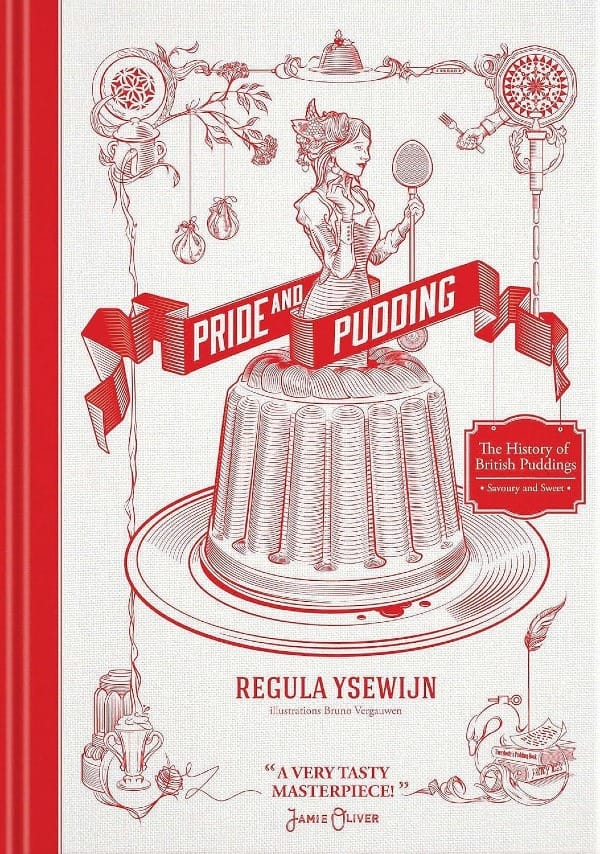Of Cabbages & Kimchi
An interview with James Read, author of a new and multi-faceted book about fermentation
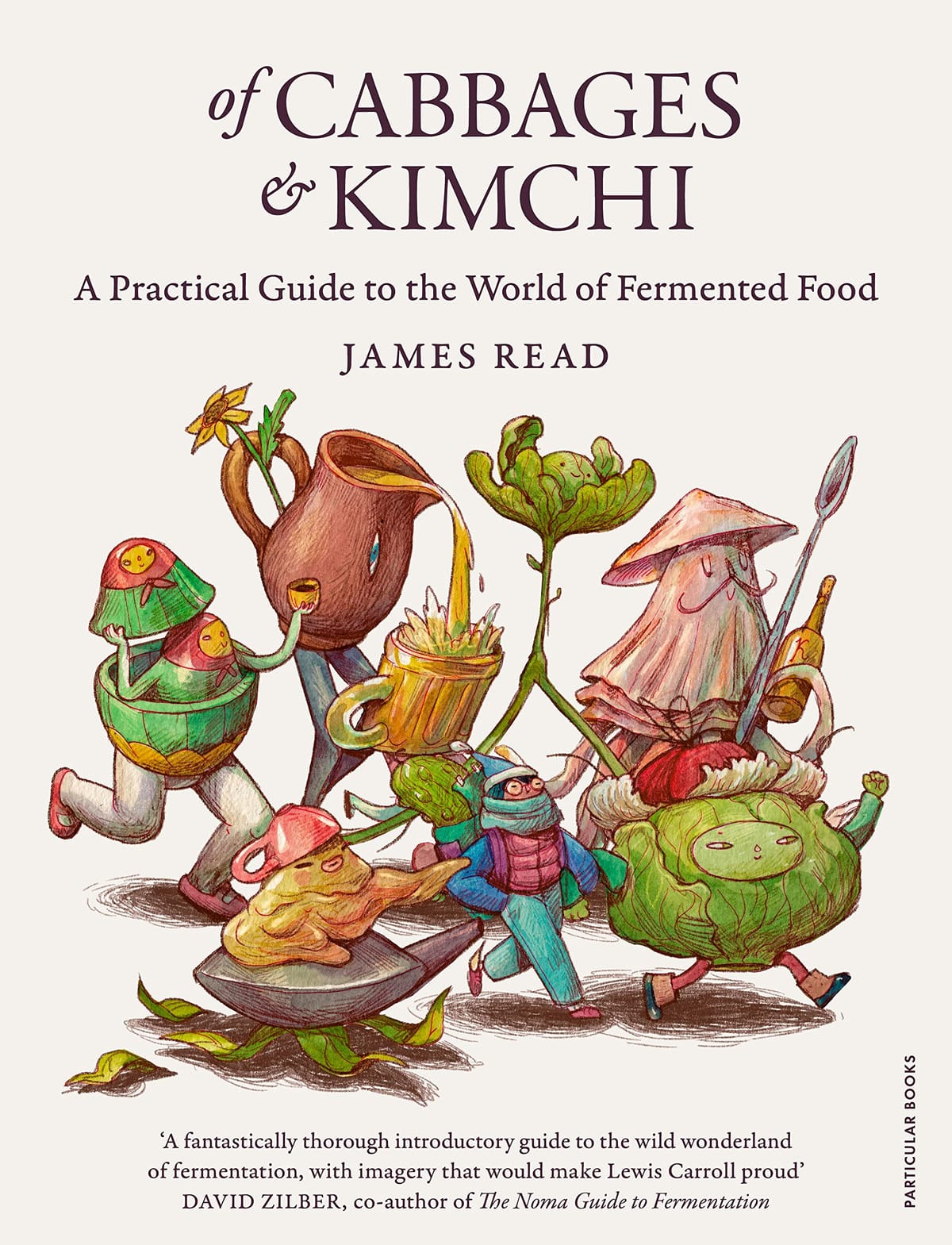
Tales From Topographic Kitchens is a reader-supported publication. To receive new posts and support my work, consider becoming a free or paid subscriber.
The response was incredible when I tweeted a cover image of James Read’s book about fermentation, Of Cabbages & Kimchi: A Practical Guide to the World of Fermented Food, a few weeks before its release. So many people replied, delighting— as I did — in both its subject and design. There are many excellent manuals about fermentation, but they don’t quite manage to capture, via beautiful language and imagery, the magical, alchemical nature of a scientific process that has been around for thousands of years in the way that Read— and Marija Tiurina, the book’s ultra-talented illustrator— do. This is a triple threat of a book. More than a manual (although it offers masses of practical information about the practice of fermentation, advice on how to choose a proper Balsamic vinegar, lists of Read’s favourite hot sauce blends, and quick troubleshooting sections, for example), he offers us a selection of well-written recipes plus contextual mythology, stories and history.
Of Cabbages & Kimchi is Read’s first book, but you wouldn’t know it, and this is, I think, down to several factors. He is a former journalist who owns a successful kimchi business; the book was four years in the making, and much of his research took place within the intense and fevered boundaries of lockdown and its aftermath, where so many of us strained at the leash (which is in itself analogous to the barely contained energy of fermentation). The result is a book that feels intensely connected to the processes it describes and the rhythms of its author’s life.
As I read Read’s book, it struck me that it was a book that might have been written by a relatively new parent (and at that point, I was unaware that Read and his partner had had a child as the book was being written and edited). At times his writing about particular ferments has an affectionate and indulgently humorous tone; it’s parental in that it talks of the everyday care and nurturing required by ferments, much like one might talk about a child. Read even has a remote monitoring system installed to watch over his kimchi business. Was he conscious of these two parts of his life running in parallel?
“That’s really true and very insightful. It’s really funny when someone else reads your writing and sees what’s desperately true and what you are self-conscious of.”
There’s nothing to be self-conscious about, though. The book is suffused with a playful, adventurous affection for fermentation which is, in itself, childlike. And the analogies with parenthood keep coming. ‘All fermentation takes time,’ he writes. It is about ‘delayed gratification’ and a sense of achievement… ‘which is that of having grown something yourself.’
“I was writing it in earnest, bridging going into lockdown and my wife’s pregnancy. I knew I had to get most of the book written before we had our child because, as a new parent, I would be committed elsewhere. So I got most of it written, about 70% before my wife gave birth, which was handy because we went into lockdown pretty soon after. Being super-conscious of the fact that I was about to become a father really informed my writing processes, and all the editing was done post being a dad. We’re blessed to have a balanced family life; we look after our daughter equally, both being semi-freelance. So she’s been part of the book all the way through.”
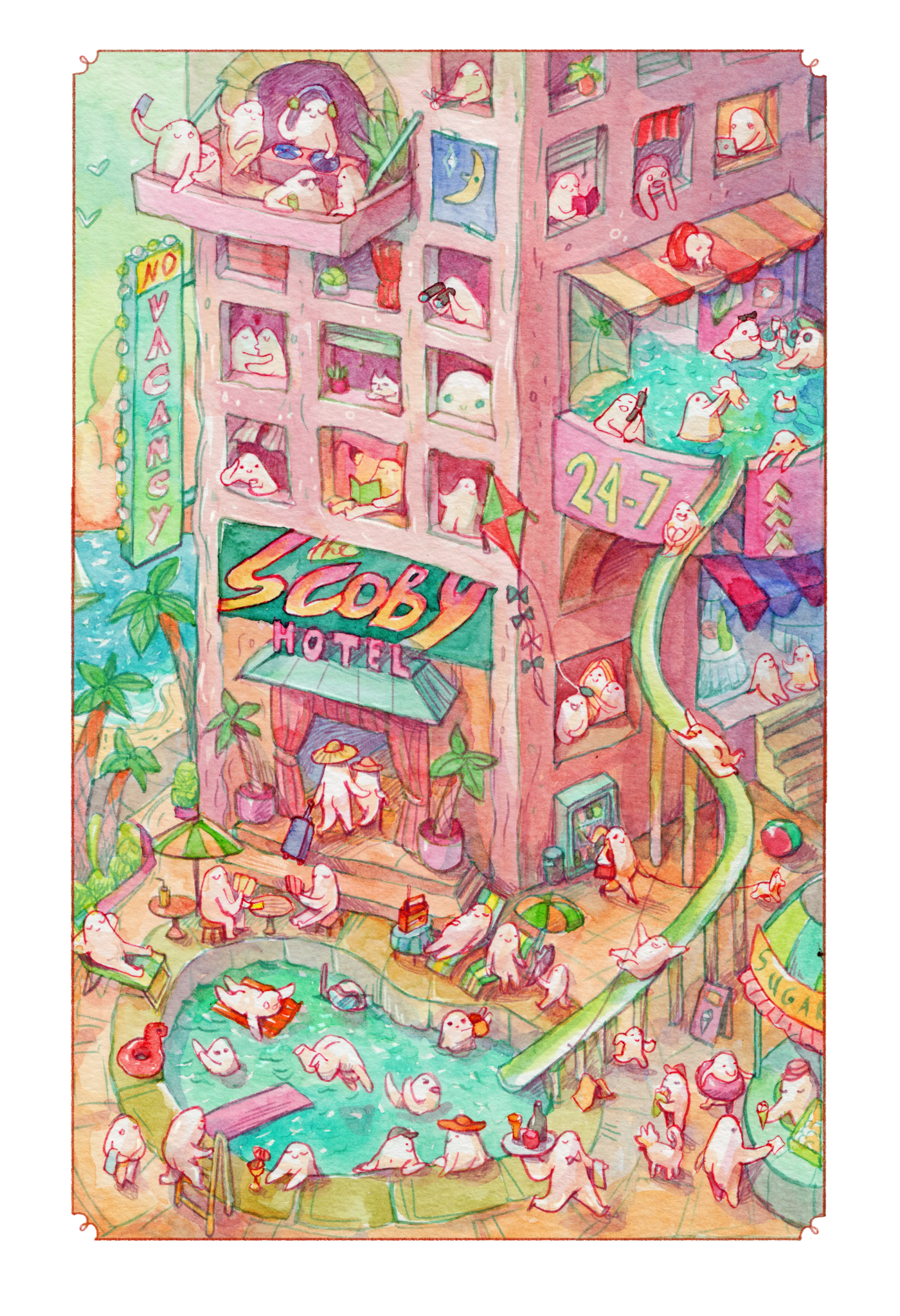
Read refers to the ‘challenge of living food’ and how one might encourage people to incorporate more ferments into their (western) diets. As he points out in his introduction, he '‘can almost guarantee that you’ve eaten or drunk something fermented today whether it’s bread, chocolate, cheese, salami, olives, wine or coffee.’ Ferments are part of our ancestral past, but like the microbes which help create them, they remain part of our lives today. “It’s not new and faddy and hipster; it’s a really old food process that has existed in all food cultures, all over the world, forever.”
“Me being raised as a child of the eighties, germs are something to remove from every surface,” he says as we discuss fermentation’s image problem. They practically pasteurised newborn babies in the postnatal ward, I tell him. (My daughter was a late eighties baby, and they treated me like a microbial threat. I remember being shown how to bathe her with a level of clean precision that one would more usually associate with an aseptic technique.) “Views have started to change,” he says, “but there’s still the hangover of that feeling that all microbes are bad, and because of that, a lot of the places where fermentation actively exists in our food processes, that is kind of censored out, so people are not so aware of the fact that they are eating loads of it every day.”
The human body is a fermenting jar made of flesh and bone. Fermentation is an embodied and visceral process. These are massive parallels with the workings of the human body before we even begin to explore what happens in our guts when we eat fermented food.
“Understanding that makes it less scary. It is a dual-pronged approach in that it’s: ‘you already eat this, so it’s too late to worry about it’, and it is not going to hurt you, and it is not new or weird. It is old and very, very well-developed. Wanting those ideas then shaped the form [of the book], and I wanted to include a good bit of history, stories, and folklore. And when I dove into that, there was just so much. But I also use the science element to empower people, so they think, ‘Oh, that is how it works, I get it, or maybe it has gone a bit wrong, but this is why.’”
It can be challenging to balance alchemic magic, folklore and science and not allow each to obliterate the other, though….“It's science and tradition, but one can feed into the other,” he says. “I always think about this with particularly complex food processes, something like coffee or soy sauce, both of which involve fermentation, of course: with soy sauce, how somebody somehow got to a point of ‘Oh, this tastes better when we do this.’” And despite the centuries of enquiry into the scientific processes behind fermentation, the origin stories of particular ferments remain a mystery, he says, kombucha being a case in point. However, Read’s evaluation of what he calls kombucha’s ‘dataset of names and loanwords’ is a useful example of how fascinating exploration is in its own right. The lack of a recordable destination, i.e. definitive ‘proof’ of its origins, become less important. Process before outcome, if you like. And his description of kombucha as a collaborative microbial soup of cooperation with a potential that reaches beyond our planet is enchanting.
“So we don’t know exactly how (a particular ferment) may have happened, but it is likely [that once upon a time] it involved a particular storeroom where things kept there happened to play host to a particular yeast culture or something that broke down the starches and proteins in a particular way that turned them into something delicious. Of course, we didn’t then know that, and we didn’t need to know that, but science and magic are working together or what we once thought of as magic becomes science, and there are so many myths and stories there.”
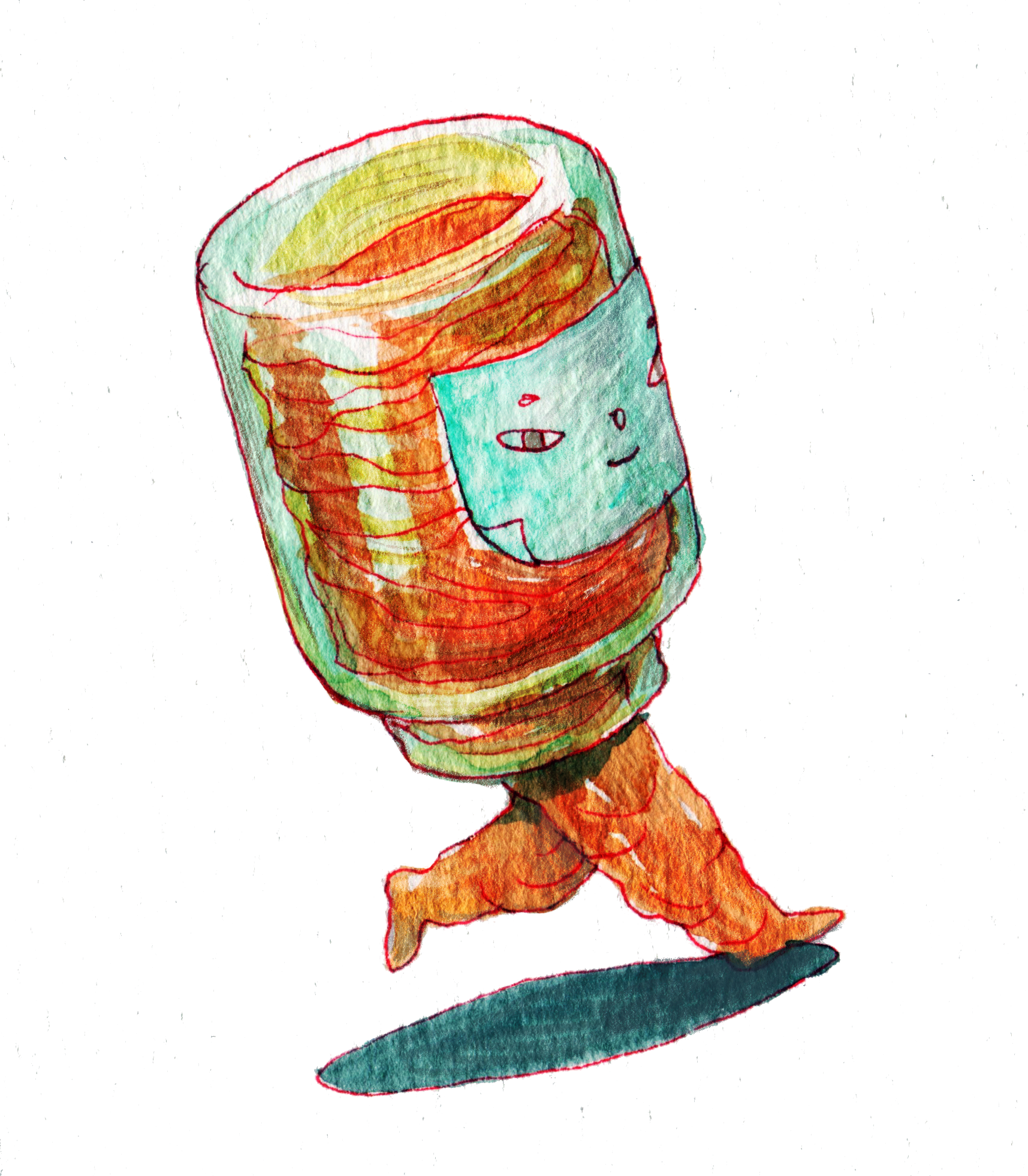
Until lockdown hit, Read spent hours in The British Library, deciphering esoteric texts, many written in languages he did not speak. “The deeper I dug, the more I found. But a lot of those stories weren’t in English. More widely-known ferments like kimchi obviously have much more written about them in English. But with kvass, to really dig deep because I don’t speak Russian, I had to start going through the texts using Google Translate wherever I could.” Read struck gold just as he was '“hitting his head against a wall”, finding a pocket-sized book about kvass published in Moscow during the sixties. “Searching the Cyrillic got me a lot further,” he says. Until its discovery, Read had only managed to find smaller paragraphs on the subject in much bigger books, so this tiny booklet helped him unlock the— till then— mysterious kvass. Google Translate is imperfect, he acknowledges, but it helped him get a grip on the subject: “Oh right, so this booklet considered cherry kvass to be kvass [proper], and I grew to understand milk kvass is kvass even though we might think of it as more like yoghurt or kefir. It helped direct me towards the right questions to ask,” he muses, because “when you are going into something where there’s not a lot of research that is accessible to you, it is hard even to know how to frame the questions and to know what to look further for.”
What did you want to include?
“I chose the ferments that were the most interesting and specific: I suppose, with the notable exception of soy sauce, I wanted things that were relatively easy to make at home, like Tepache. But soy sauce is definitely difficult to make at home. Still, it is also a relatable way of drawing [western] people into the conversation on fermentation.” As Read says, “you are already eating it.”
And what didn’t you want the book to be?
“When I saw how broad the subject of fermentation was, I thought, ‘okay, I don’t want to cover bread. I don’t want to cover cheese, beer, and alcohol’ because, frankly, I think those things are really heavily written about: they are all books within themselves. Critically I like being really excited about things that are living ferments. So I decided only to cover ferments that [at least potentially] arrive at your lips as being still alive or full of microbes. I use the term ‘potentially’ because this is the thing that makes fermented foods so brilliant. You can’t call something probiotic without many assessments to prove there’s a living ferment in every batch you make, which is a bit too onerous.”
We discuss the idea that the very nature of ‘living food’ means that sometimes it may cease to be alive, and this is a normal, natural thing. I’m reminded of anatomy labs where specimens float in jars, and fermentation, to a certain degree, might remind people of these too, which could be offputting. Yet, unlike anatomical specimens, fermented things in jars are alive and not fixed in time and space, I comment, and he corrects me: this is not always the case.
“Vinegar definitely fits this,” he says, adding that its inclusion in his book is because he finds it “fascinating that it is a ferment that does include microbes, but it is a really different process and not all of the vinegar you buy will be living. The methods I give will leave you with an unpasteurised vinegar far more likely to be a living one.” ‘Vinegar is a fermentation anomaly,’ he writes, ‘every other ferment in the book wants to be starved of oxygen….vinegar is the opposite- it is aerobic. Like us, it loves oxygen.’ He tells us it is a slow process, so what vinegar makers do to expedite it is quite clever: they use a microbe-rich starter commonly known as a ‘mother’.
And this is where the genius choice of Marija Tiurina as illustrator really hits me. Read’s chapter on vinegar is prefaced with a double-page illustration in shades of pink, clementine, and the palest of greens showing an ethereal long-haired mother, her arms around tiny mini-me children who sit in her lap to read or gather green apples and chase insects with nets. It is romantic but also hints at the responsibility of the fermenter to keep their little microbe offspring safely contained. It reflects the book’s sense of magical, nourishing guardianship. We make and consume vinegar, and it becomes part of us.
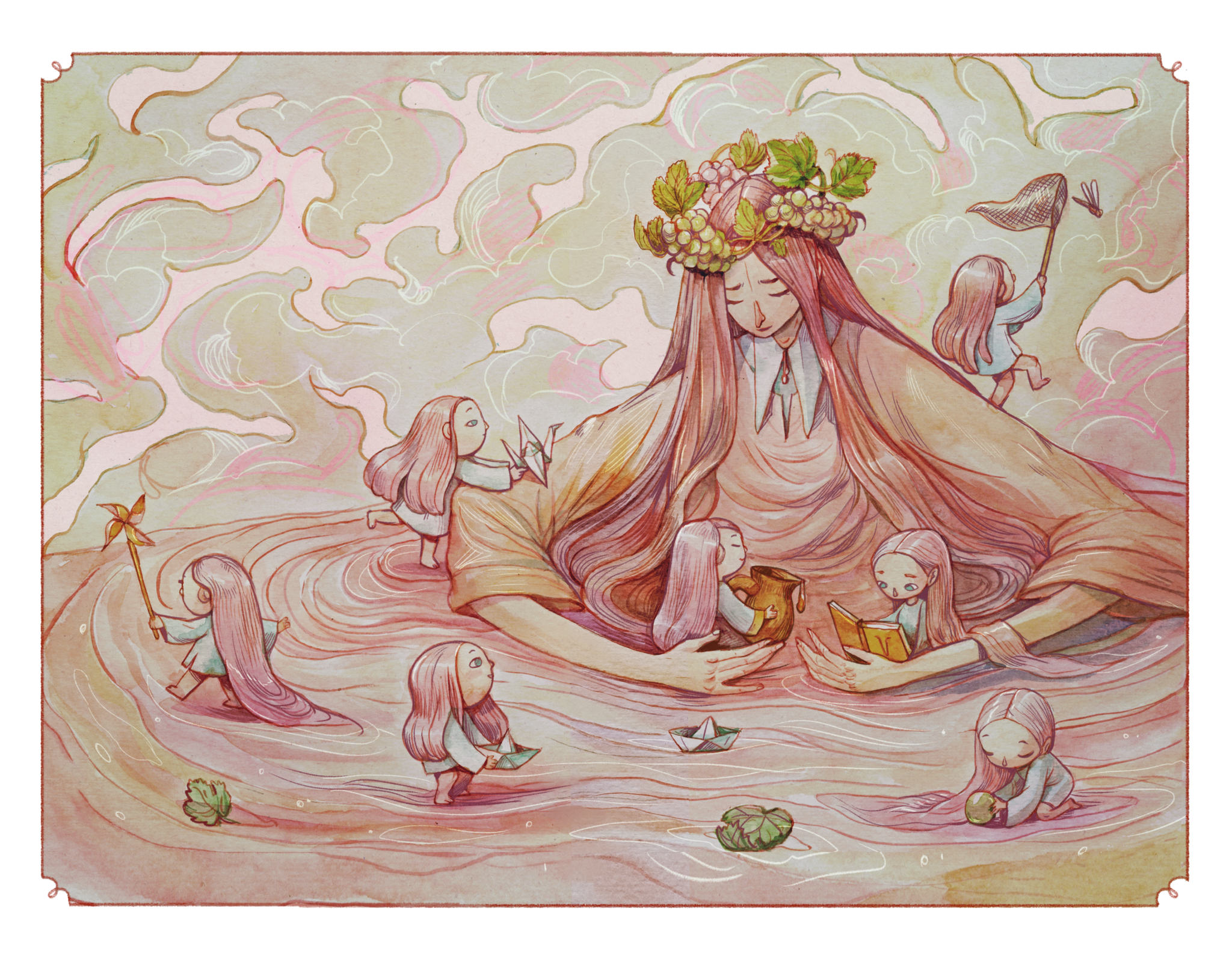
How did you first encounter Marija?
“Years ago, when I was working as a journalist, one of my first jobs was writing for an arts and culture publication, and one of their predominant focuses was graphic illustration. So I came across many illustrators, and that gig sparked my interest in illustration. When I was looking for illustrators, I had a kind of style in my mind which was something like hers. I made a list of artists and kept looking and found a couple of illustrators that I was like, ‘yeah, they’re alright’, but the more I thought about it, the more I realised I would be sad if it weren’t Marija. I sent her details to my editor so they’d only have one person to say no to and thankfully, they didn’t. They said, ‘yes…she’s quite weird’. I had a bit of a vision, but I definitely did not have a vision of how the book finally turned out. It’s been really nice working with Marija. I just went, ‘ I trust you; I know that generally your style is awesome, and you get this idea of tiny microbes and living things’, and I knew she’d get it. I didn’t need to brief her too specifically.”
And how does the collaborative process work?
“ My editors and I went through the book and picked out the choice phrases we wanted her to respond to. We gave her more than we needed, asking her to pick the ones that sparked something within her and see what happened. She got these prompts along with the whole book so she could look through it and gain context, and she came back with all the illustrations, basically as you see them. She gave us rough drafts that weren’t fully coloured, but really little has changed. We were thumbs up; these are all brilliant.”
The decision not to use a photographer was wise: photographs would detract from Read’s beautiful writing and storytelling. “Really early on with the book, I had this thought that obviously when you write a food book, photographs are what you do, and I have taken photos for years, and yet still I didn’t really have an idea of what brilliant photos of fermented foods might look like, even if I did them. Things in jars?” He laughs. “You make a couple of really attractive photos of that for a magazine or something but a full book of them is going to be repetitive things on plates, things in jars, things with a lot of other things that are not the actual thing to jazz it up a little more.” I keep thinking of specimen jars as he says this. “Also, then because I wanted a book that was as much prose as it was recipes, then it would become like, ‘okay, cool, so I am going to need a photographer who can go to Japan and photograph the making of cedar barrels’, which is massively expensive and definitely not something I was going to get as a first-time author.” And not just after lockdown either. Many countries mentioned in Read’s book were completely closed to visitors and have been until relatively recently. “So when Marija said yes, I thought this will be fine and a great partnership. It seems to me that Of Cabbages & Kimchi has a distinctive microbiome, I say. “Yeah, it doesn’t feel like having a few photo plates would have really conjured up what I wanted to put across, and I am so very, very happy Marija agreed to do it; otherwise, the book would always have been secondary to what I imagined it might have been. Marija’s illustrations make up so much of the book. It’s such an important thing to be able to draw people in and give them a real idea of the playfulness and weirdness of my book’s tone.”
Despite the fantastical nature of the book’s design, Read is clear on the freedom to be found within the confines imposed by its practical safety rules. “Once you understand these rules, you can play with them. Go a bit more freeform. And once you start to see those processes everywhere in food, it unlocks parallel processes where you think, ‘Oh, if I can do that with it, I can also do this with it.’ I think fermentation can be playful and innovative; many chefs I really look up to use fermentation in this way. A guy I know makes miso out of absolutely everything: he’s made miso using a Colin the Caterpillar birthday cake and made it out of Greggs sausage rolls. You can make miso from anything that gots protein in it in his eyes. He also makes miso out of very lovely old British legumes and beans; that’s his main thing, and the rest is a playful hobby where he transforms things people send him into miso. So once you understand how fermentation works, it is very free and open.”
When I looked at Maria’s website, I was struck by one particular artwork titled ‘Plants Look After You’. There’s a lot of discussion about the effects of fermentation on our digestion and microbiome. I wondered what feelings Read might have about the process's effects on one’s psyche. What might the emotional benefits of fermentation be, I ask. “It is kind of a unique process within cooking where you’re bringing something to life, and every time I ferment something, even now when I have been doing it for years and years, day in and day out because it is my job, it is still really exciting. ‘Look, I have returned, and it is all fizzy’. And that part is a little bit more like gardening than cooking: seeing the first shoots peek out when I cultivate something. I brought it into being. That’s what I wanted to put across.”
Some of James’s interview responses have been condensed and edited for flow.
Find James on Twitter and Instagram.
Marija Tiurina’s website can be found here.
A link to James’s ‘Ask Me Anything’ session about fermentation on Reddit.
And what of the recipes?
Some of my favourites include Pineapple & Cinnamon Tepache and a chipotle-glazed Ham in Tepache with Beans, Soy Caramel Dark Milk Chocolate Tart, Radish Winter Kimchi (Dongchimi Kimchi), Green Chilli Fermented Salsa, Oatmeal Stout Pickled Onions, and Quince Baked in Kombucha.



